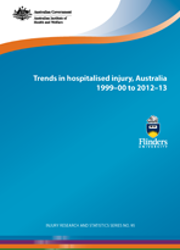Summary
This report describes trends in the occurrence of injuries requiring hospitalisation in Australia from 1 July 1999 to 30 June 2013. The annual number of cases rose from about 327,000 to 447,000 during this period.
Injuries in 2012-13
Overall, injuries were more common among males (250,440 cases) than females (196,233 cases). Case numbers and population-based rates were higher for males than females for all age groups to 60-64, the largest difference being for ages 15-24. Rates were higher for females than males for age groups 65-69 and older. The oldest group (85+) had the highest rates.
There were an estimated 22,277 cases due to injury and poisoning for Indigenous people during 2012-13. More males than females were hospitalised (1.3:1). Rates of injury among Indigenous people (3,513 cases per 100,000) were twice those of non-Indigenous people (1,806 cases per 100,000) in 2012-13.
The average length of stay in hospital as a result of an injury was 4 days (more than 1.7 million days for the 447,000 cases). Length of stay in hospital increased with age to an average of 7 days for people aged 65+. About 1 in 6 injury cases were classified as 'high threat to life'. The percentage of high-threat-to-life cases increased with age to 29% of cases at 65+.
Two of the main causes of injury in 2012-13 were falls (40%) and transport crashes (12%). Over 170,000 people were hospitalised as a result of a fall in 2012-13. About 53% of the falls cases were people aged over 65 years and about 66% of the cases in that age group were females. Transport crash injuries were more common in males (36,877 cases) than females (17,728 cases) and rates were highest for age group 15-24.
Trends in injury cases
The age-standardised rate of injury increased from 1999-00 to 2012-13 by an average of 1% per year. The rate of injury was 1,736 cases per 100,000 population at the beginning of the period, and by the end the rate was 1,888 per 100,000.
Increases in age-standardised rates across the period were found for injuries due to: falls (2% increase per year) and intentional self-harm (0.4% increase per year). Significant decreases occurred in the rate of hospitalised cases due to poisoning by pharmaceuticals (4% per year) and by other substances (4% per year), and drowning and near-drowning (1% decrease per year-3.5% per year for boys 0-4 and 2.8% for girls 0-4). No significant trends were observed for transport-related injuries, assaults and thermal injuries such as burns.
Trends in injury among Indigenous people
Rates of injury for Indigenous males and females increased over the period, rising more rapidly in recent years. A similar rapid rise was not seen for non-Indigenous Australians. There were increases in rates of poisoning by pharmaceuticals, falls, intentional self-harm and assault during this time.
Summary
- Injuries in 2012-13
- Trends in injury cases
- Trends in injury among Indigenous people
1. Introduction
2. Overview of hospitalised injury
3. Severity of injury
4. Transport crashes
5. Drowning and submersion
6. Poisoning, pharmaceuticals
7. Poisoning, non-pharmaceutical substances
8. Falls
9. Thermal causes of injury
10. Other unintentional injury
11. Intentional self-harm
12. Assault
End matter: Acknowledgments; Abbreviations; Symbols; Glossary; References; List of tables; List of figures; List of boxes; Related publications



